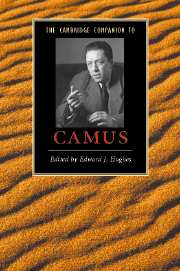Book contents
- Frontmatter
- Introduction
- PART I: BIOGRAPHY AND INFLUENCES
- PART II: THEMES, PREOCCUPATIONS AND GENRES
- 4 Rethinking the Absurd: Le Mythe de Sisyph
- 5 Camus and the theatre
- 6 Camus the journalist
- 7 Camus and social justice
- 8 Violence and ethics in Camus
- 9 Camus and Sartre: the great quarrel
- 10 Portraits of women, visions of Algeria
- PART III: TEXTS AND CONTEXTS
- Postface
- Guide to Further reading
- Index
- Series List
10 - Portraits of women, visions of Algeria
from PART II: - THEMES, PREOCCUPATIONS AND GENRES
Published online by Cambridge University Press: 28 September 2007
- Frontmatter
- Introduction
- PART I: BIOGRAPHY AND INFLUENCES
- PART II: THEMES, PREOCCUPATIONS AND GENRES
- 4 Rethinking the Absurd: Le Mythe de Sisyph
- 5 Camus and the theatre
- 6 Camus the journalist
- 7 Camus and social justice
- 8 Violence and ethics in Camus
- 9 Camus and Sartre: the great quarrel
- 10 Portraits of women, visions of Algeria
- PART III: TEXTS AND CONTEXTS
- Postface
- Guide to Further reading
- Index
- Series List
Summary
Although countless books have been written on Albert Camus, critical monographs devoted to portraits of women in his works are extremely limited in number. To date, only two books have appeared on the subject: Anthony Rizzuto's Camus: Love and Sexuality and Geraldine Montgomery's Noces pour femme seule: le féminin et le sacré dans l'oeuvre d'Albert Camus (Nuptials for Woman Alone: the Feminine and the Sacred in the Work of Albert Camus). Nevertheless, a number of articles have been devoted to the feminine, and especially the maternal, in Camus's fiction and theatre. With the posthumous publication of Le Premier Homme in March 1994, considerable attention has once again focussed on the mother figure in his work, associated, more than ever, with Camus's beloved homeland, Algeria.
The mother figure is central to Camus's work, even when she is more absent than present, as in L'Etranger. In fact, a number of absent women haunt Camus's fiction: Rieux's wife in La Peste and the woman on the bridge in La Chute, to cite but two examples. As for supposedly secondary characters like Marie and even more so the Arab nurse in L'Etranger, they are anything but minor figures. Camus himself remarked in 1959 that the characters dearest to him were, along with Céleste, the café-owner in L'Etranger, Marie and, from Les Justes, Dora (Ess, 1922). With respect to the nurse, whom very few critics have considered, Patrick McCarthy devotes an eloquent albeit brief essay to this woman - watching over the French-Algerian dead - who, in her association with Meursault's mother, already foreshadows the psychoanalytical and political dimension that will characterise the second part of the novel.
- Type
- Chapter
- Information
- The Cambridge Companion to Camus , pp. 131 - 144Publisher: Cambridge University PressPrint publication year: 2007
- 2
- Cited by

